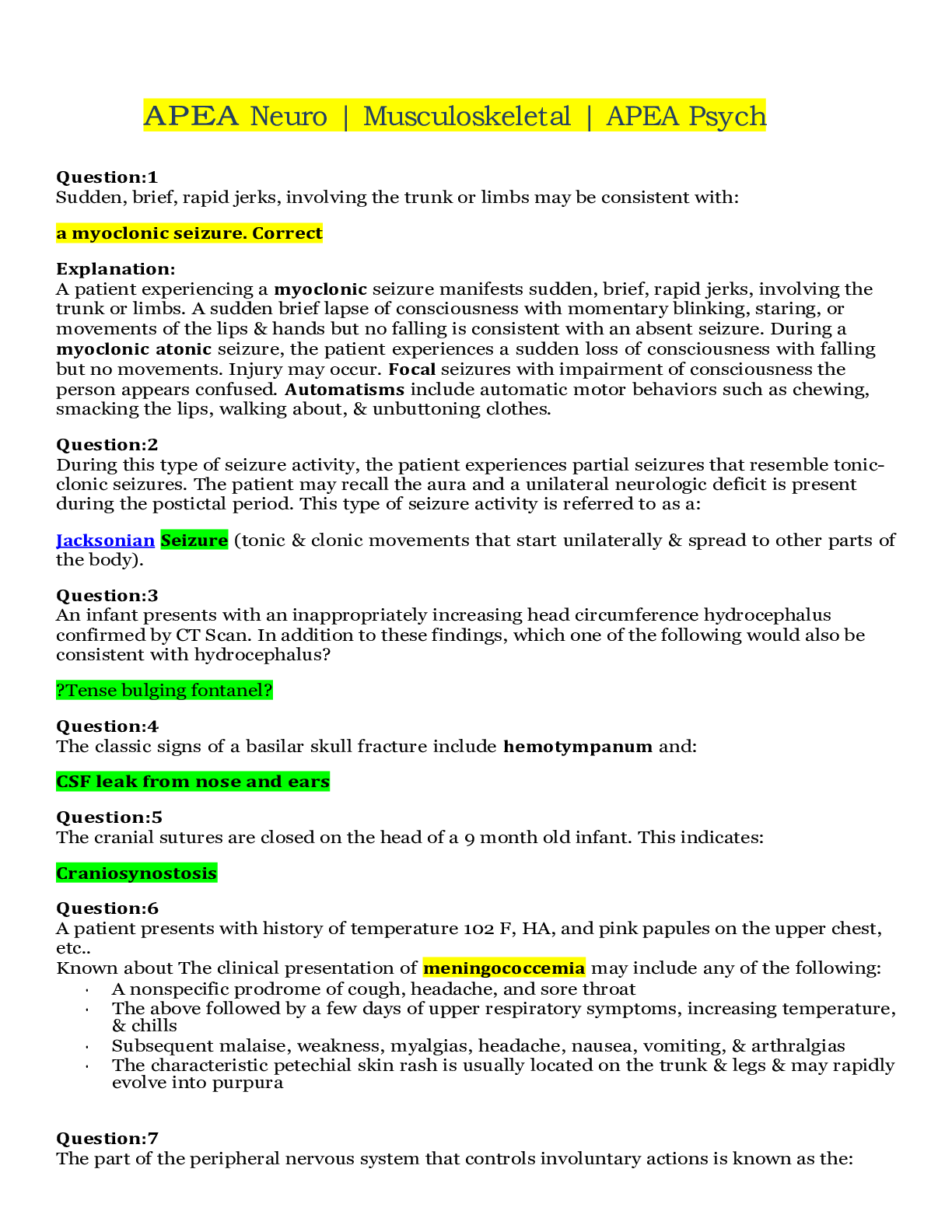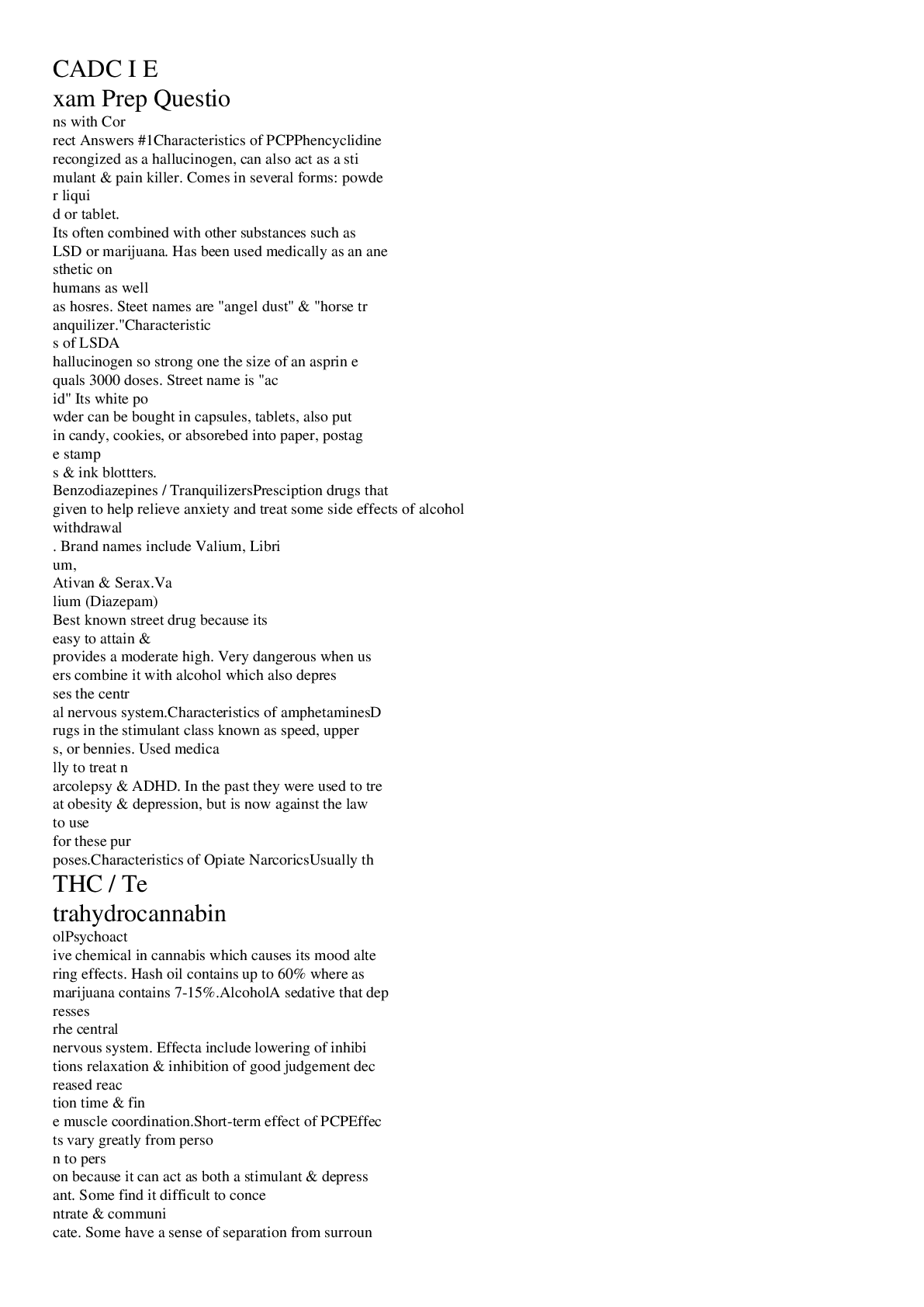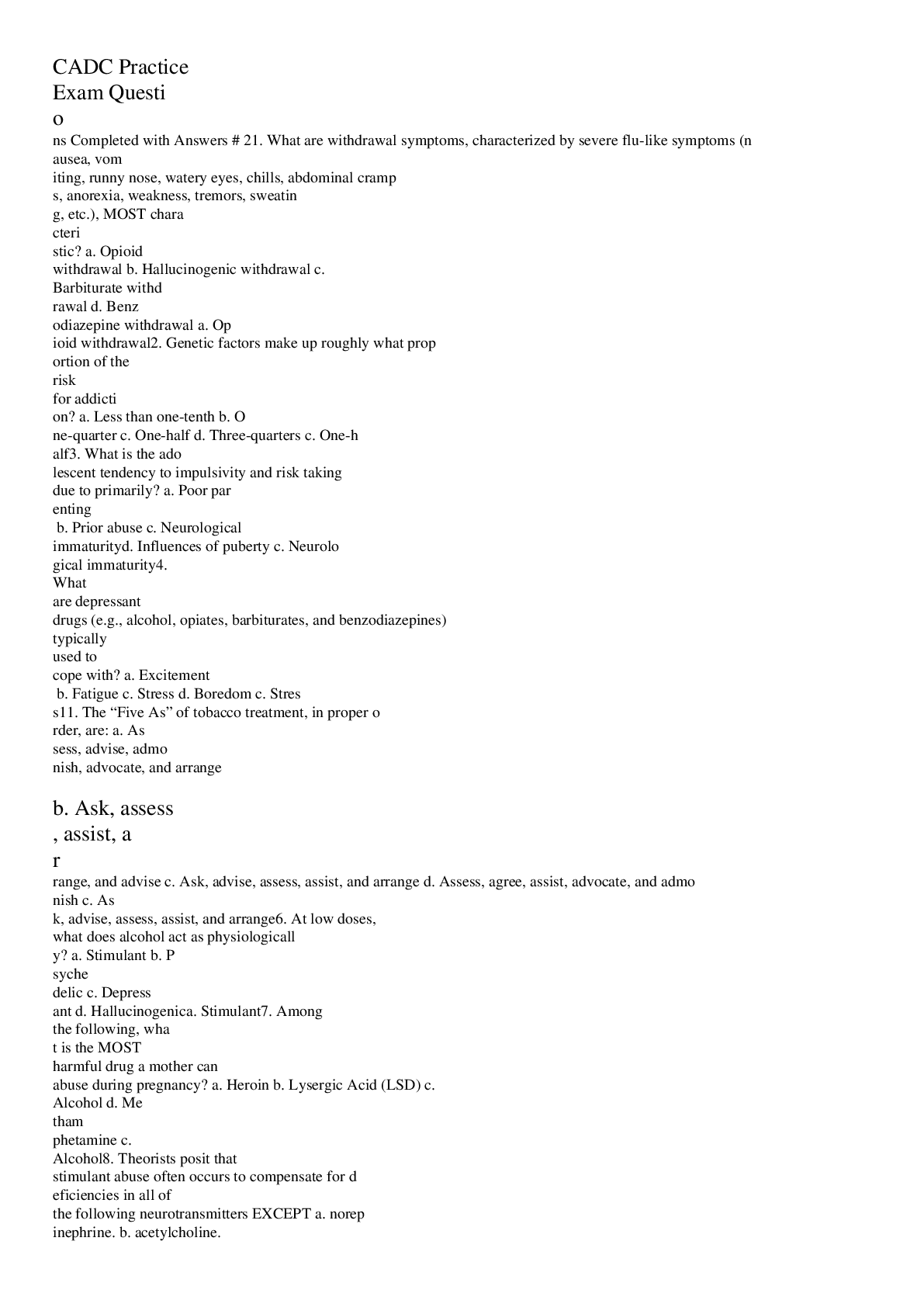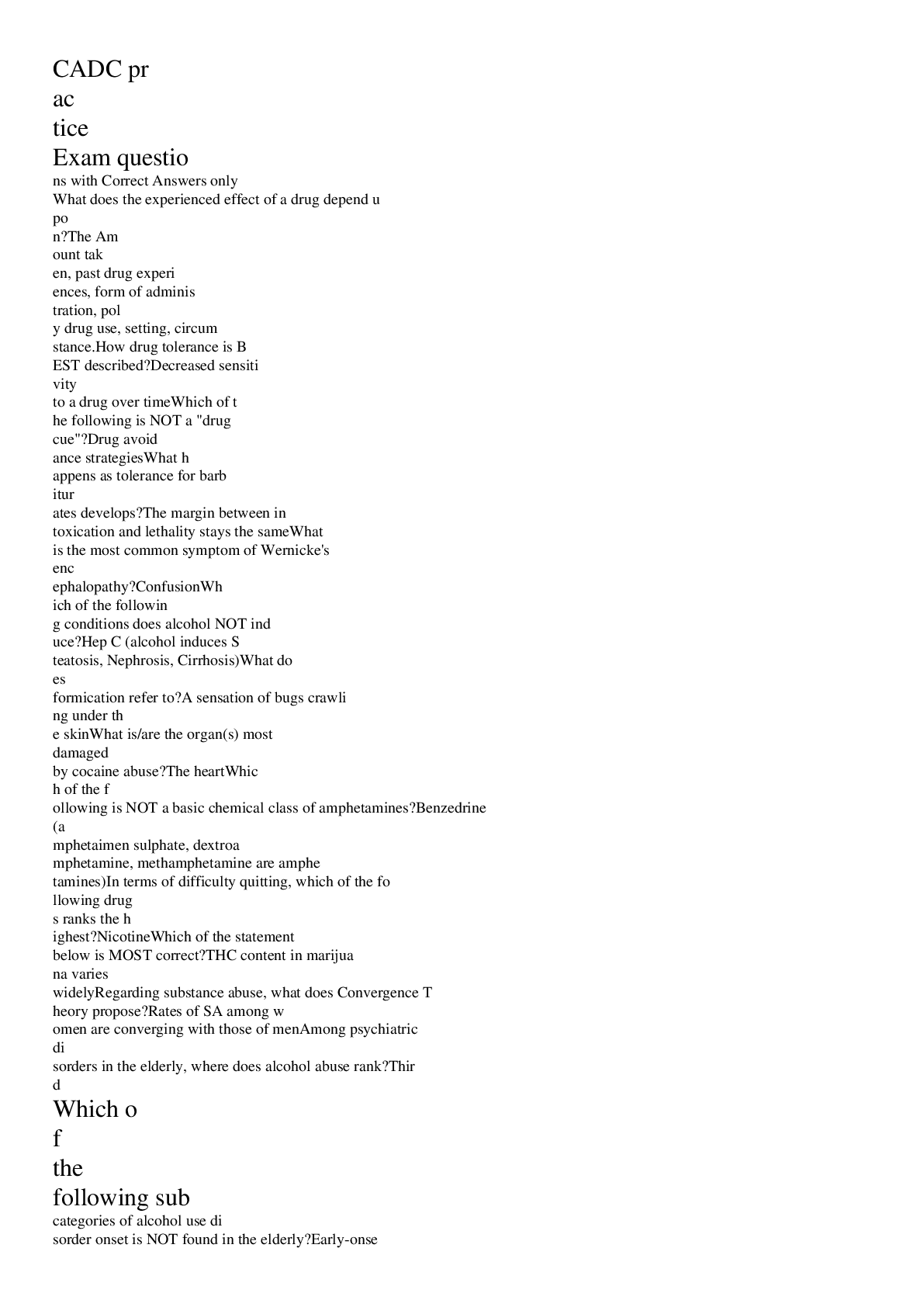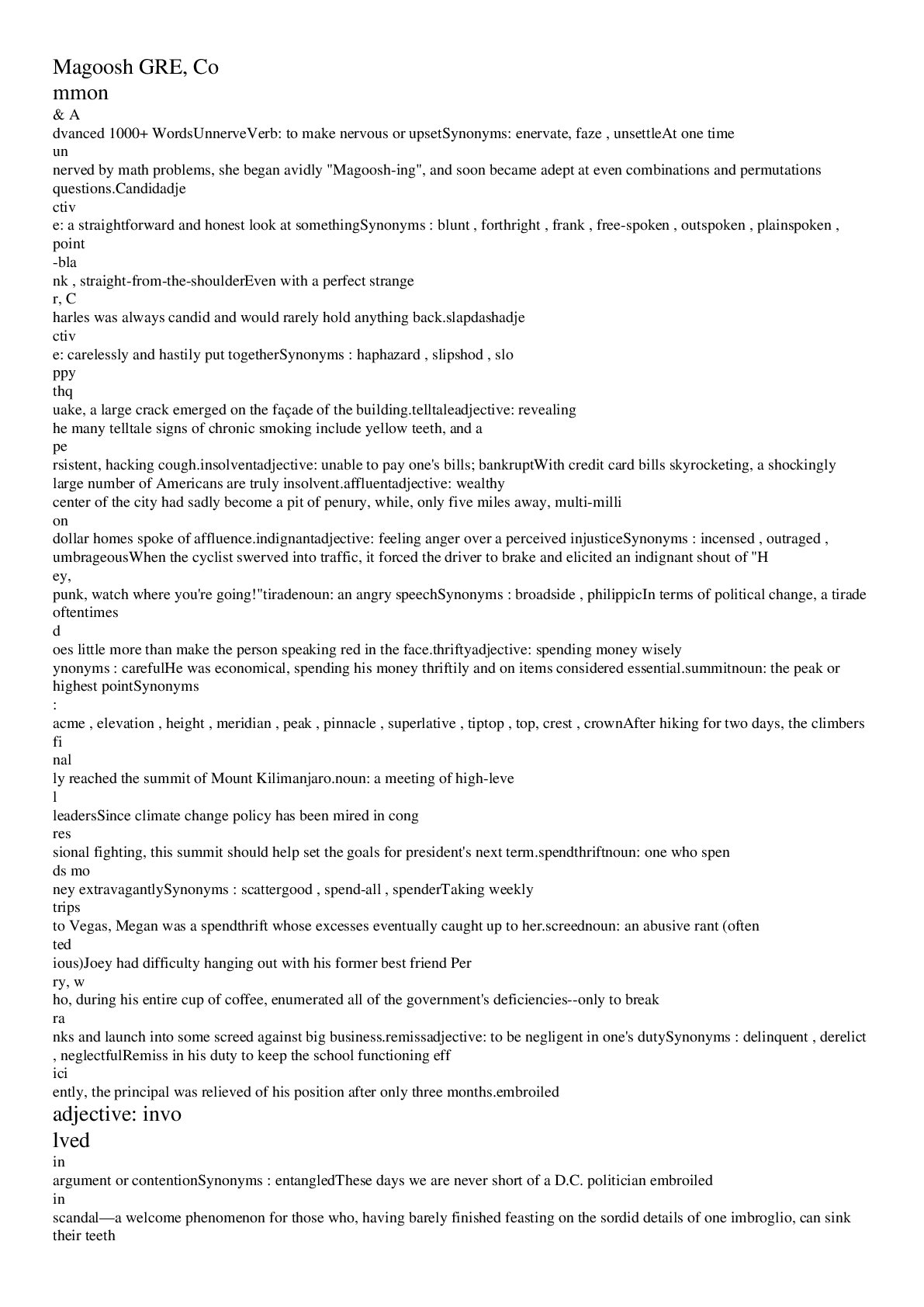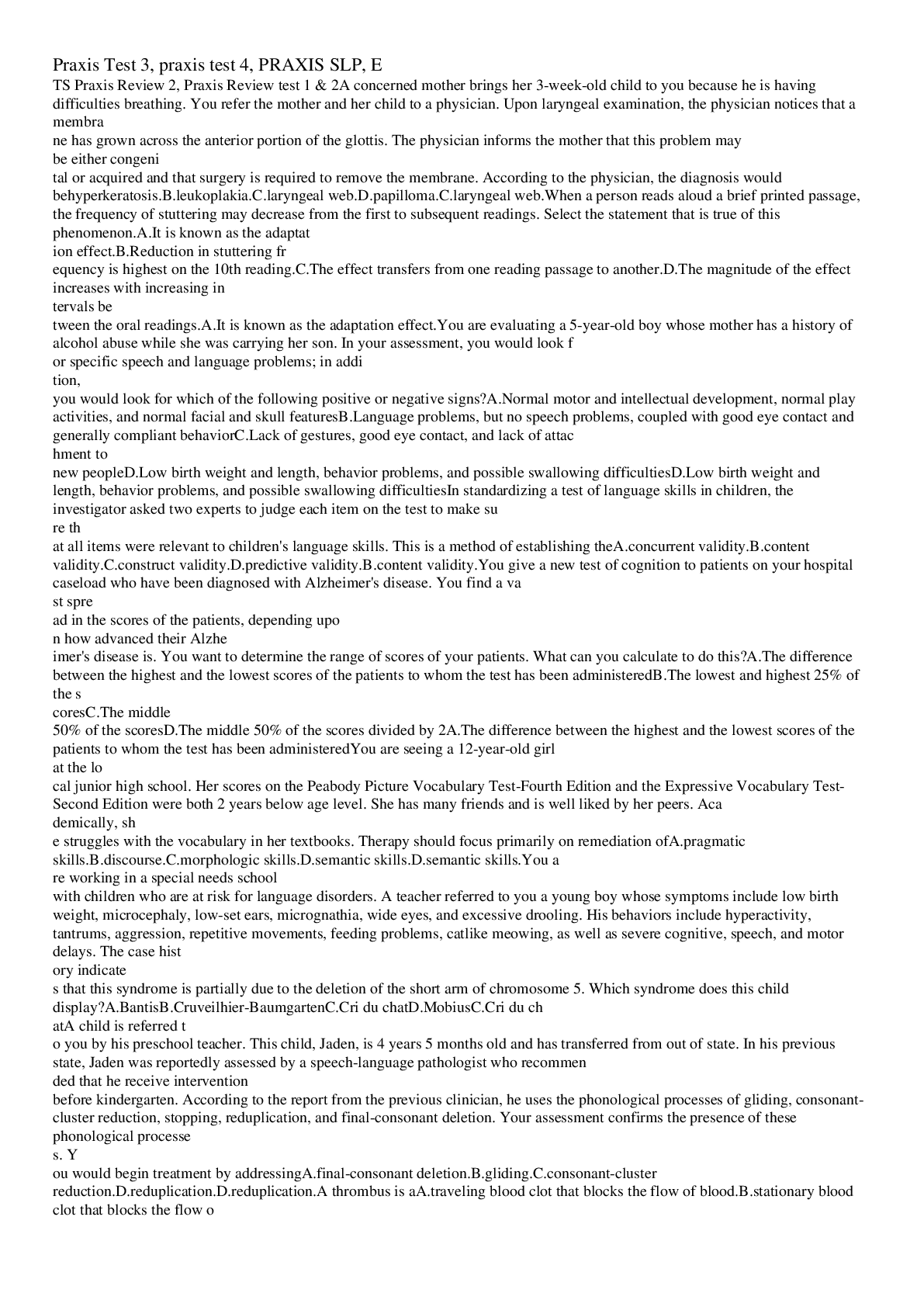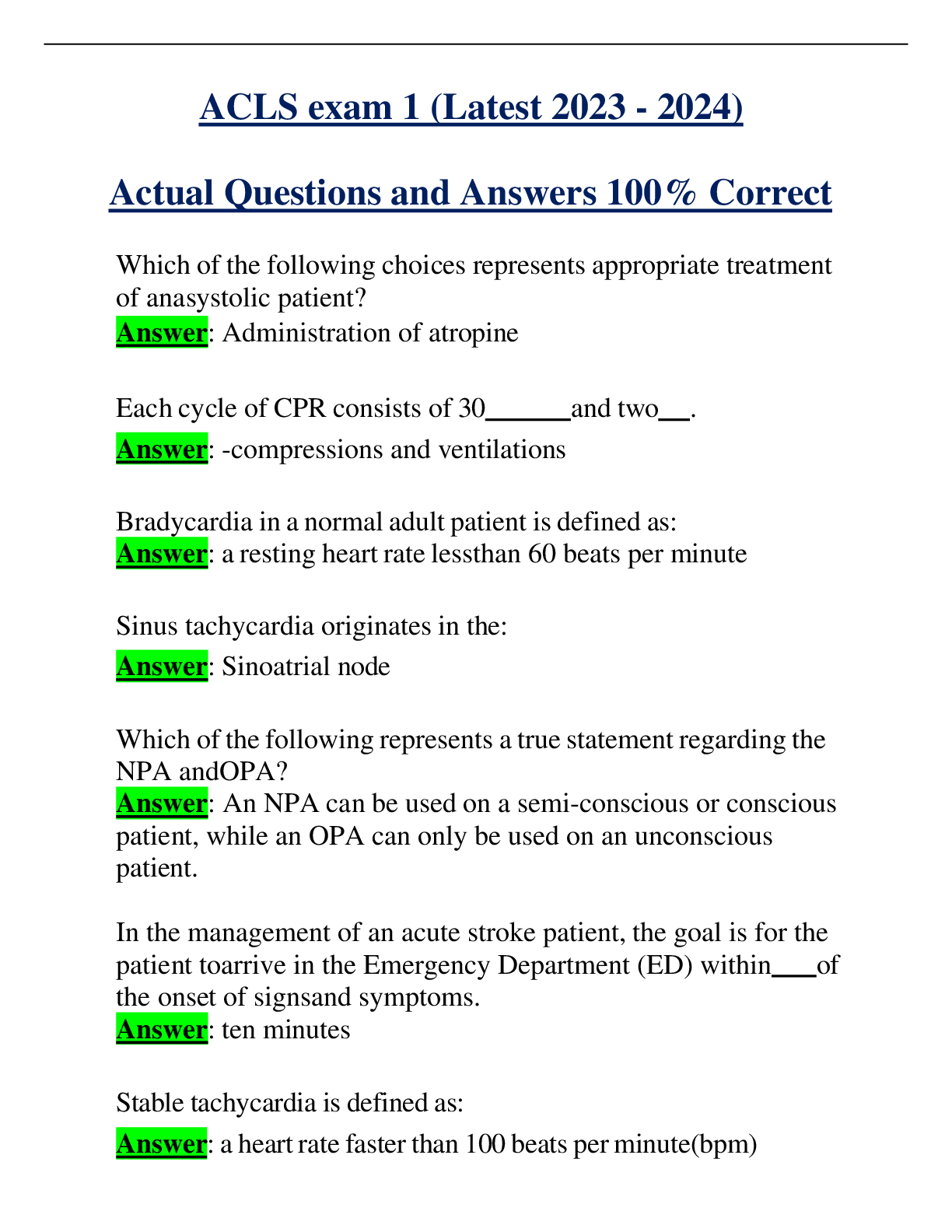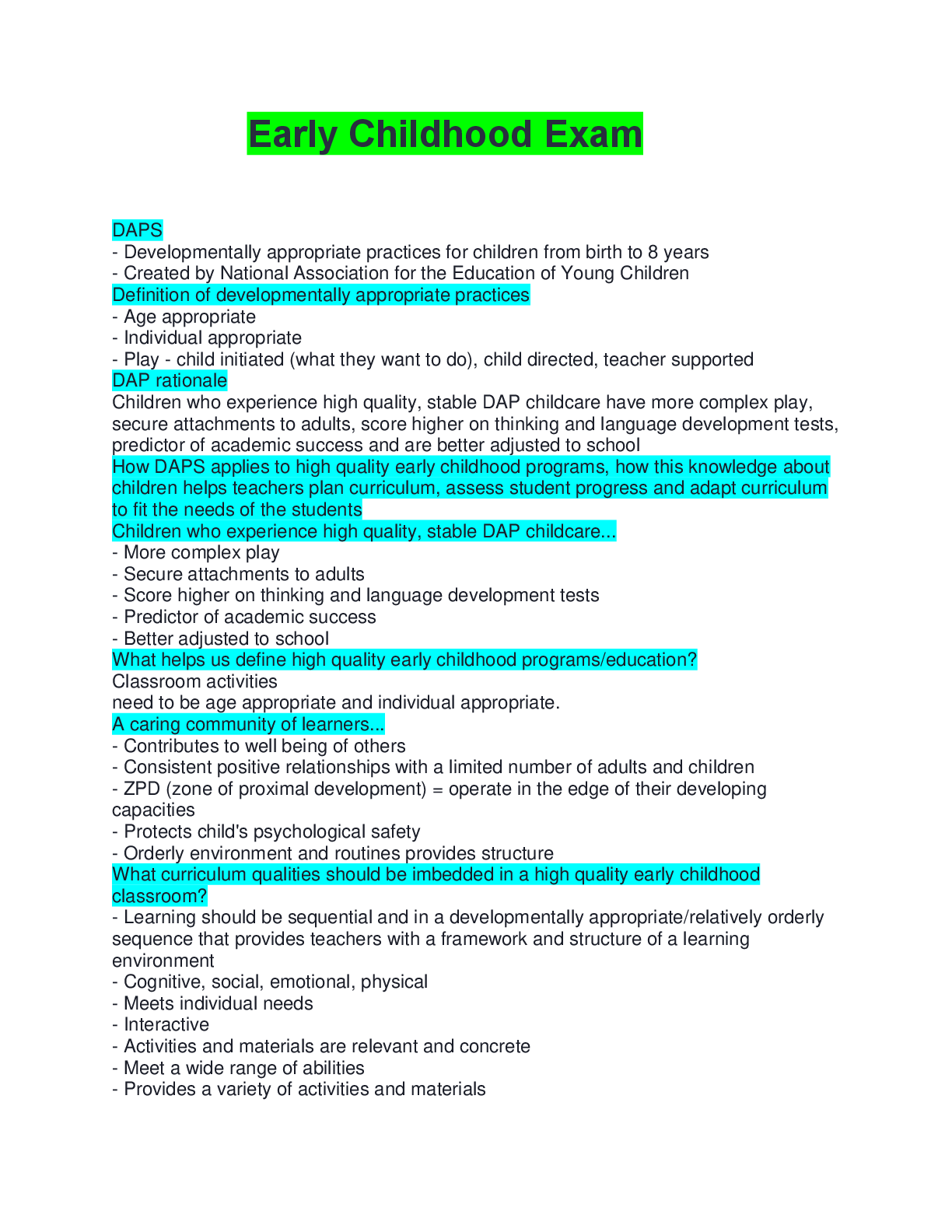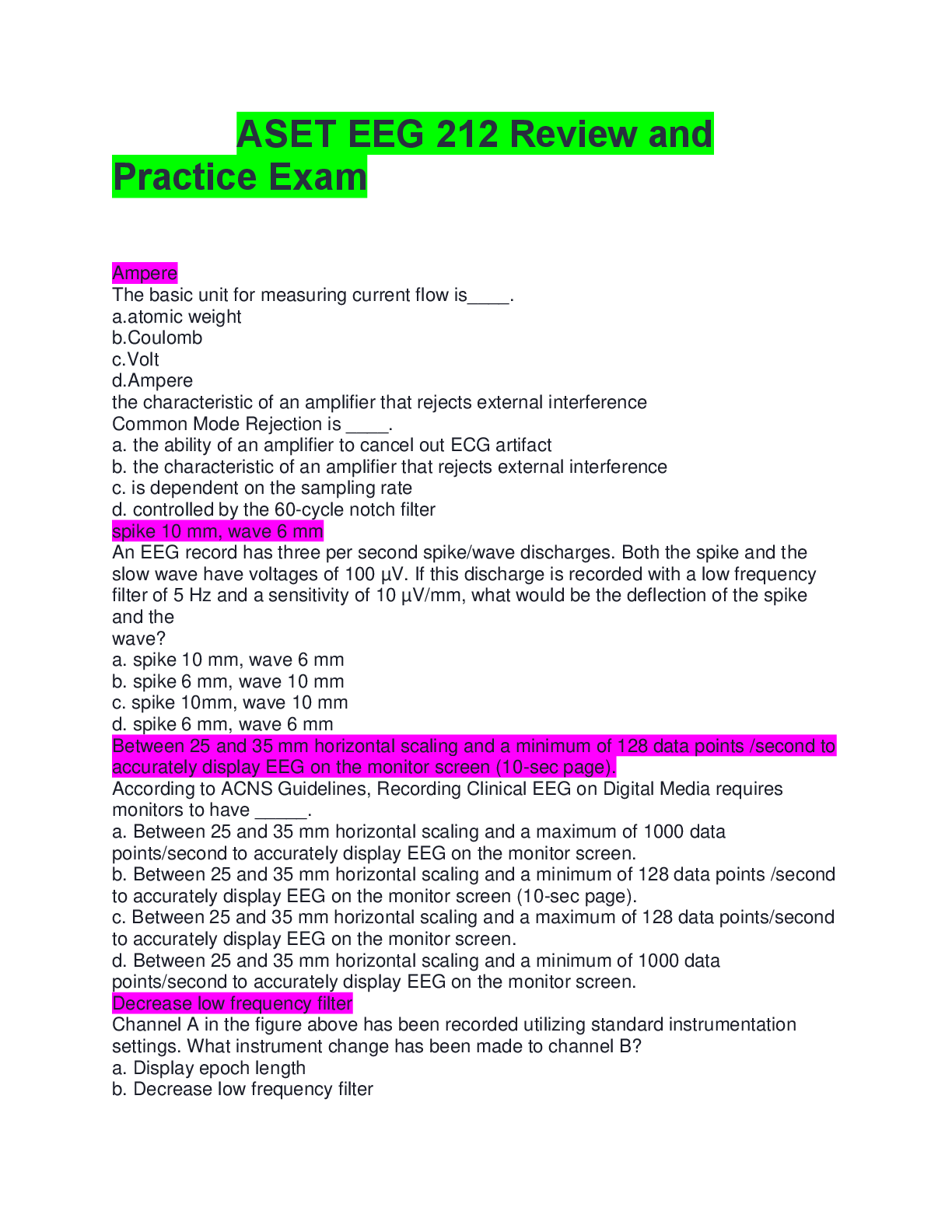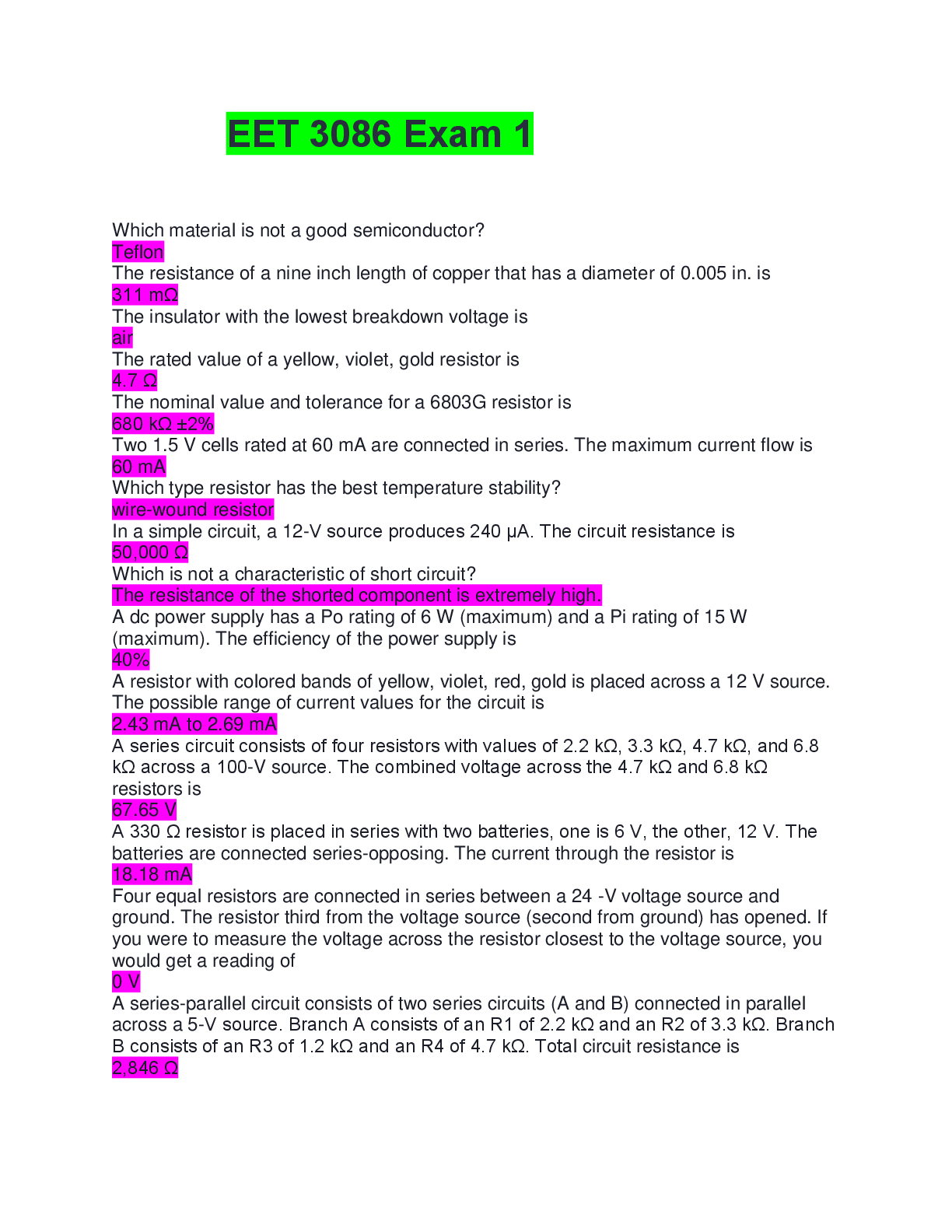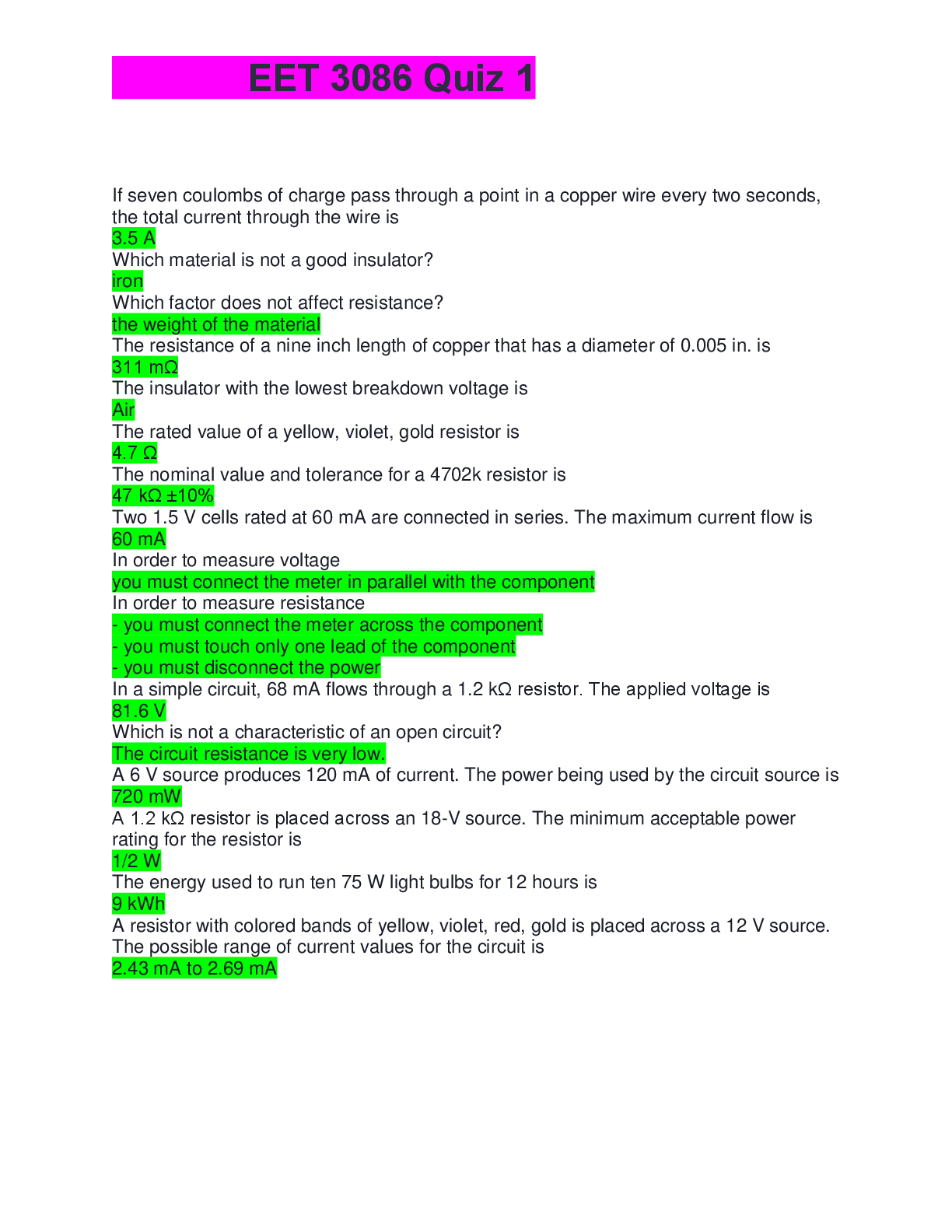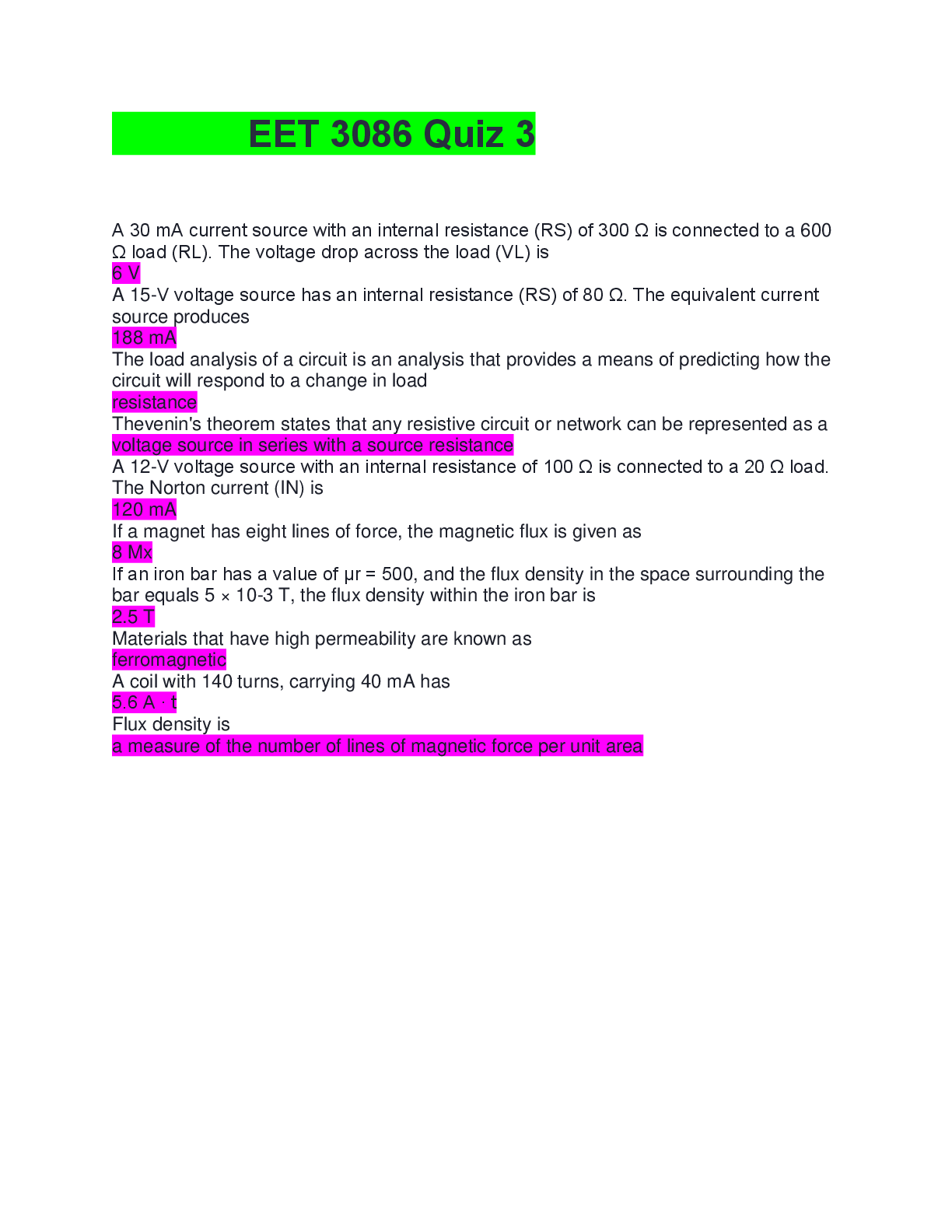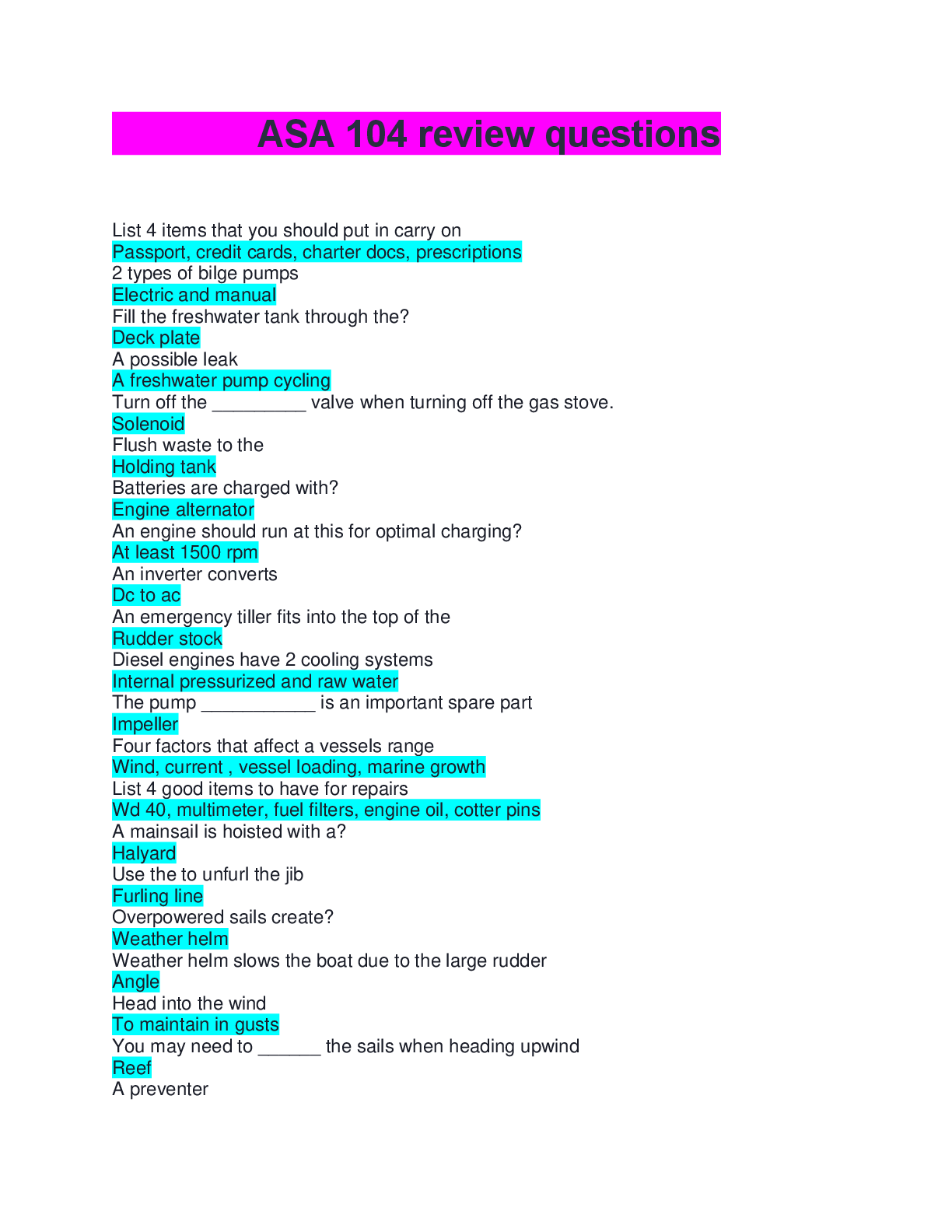Counseling > EXAM > CADC IL CADC Exam Questions CORRECTLY ANSWERED (All)
CADC IL CADC Exam Questions CORRECTLY ANSWERED
Document Content and Description Below
CADC IL CADC Exam Questions CORRECTLY ANSWERED CADC IL CADC Exam Questions Definition of Counseling a professional relationship that empowers diverse individuals, families, and groups to accompli ... sh mental health, wellness, education, and career goals Counseling is a.... Co1laborative process sensitive to individual client characteristics, influence of significant others, and client cultural and social context Counselors help clients to 1. Explore and enhance their motivation to chance behavior 2. Set appropriate treatment goals 3. understand the structure, expectations, purpose, and limitations of the counseling process Counselors must continually evaluate the client's level of risk regarding personal safety and relapse potential in order to anticipate and respond to crisis situations like high risk situations Counselor skill include knowing how to individualize treatment plans, adapt counseling strategies to client charactistics and circumstances, apply culturally and linguistically responsive communication syles and practices The effectiveness of addition treatment is measured by Client's improved functioning, reduced suffering, psysiological indicators, retention in treatment, enhances interactions with other people, work performance The connection between the client and the counselor is the therapeutic alliance 3 components of the therapeutic alliance 1. relationship or bond b/w the therapist & client 2. consensus b/w the two regarding treatment techniques/methods 3. consensus b/w the 2 regarding treatment goals The collaboration occurs when the clinical knowledge of the counselor combines with the experiential knowledge of the client because the client is the true expert in their life over 80% of positive treatment outcomes may be due to the therapeutic relationships contributing elements of warmth, empathy, and respect for the client Motivational Interviewing (MI) a directive, client-centered style for eliciting behavior change by helping clients explore and resolve ambivalence. The fuel for the chamce process is the client's motivation to make the change. Can enhance motivations starting at the screening and lasting through the treatment process Motivational style of counseling communication is based on the following assumptions 1. Ambivelnce about change is normal and creates a significant obstacle to the recovery process 2. Ambivalence can be resolved by working with the client's intrinsic motivations and values 3. The alliance b/w counselor and client is a collborative partnership to which each brings important expertise 4. An empathetic, supportive yet directive counseling style provides conditions under which change can occure 5. direct argument and confrontaion may tend to increase client defensiveness and reduce the liklihood of behavioral change 5 general principles of MI 1. Express empathy thru reflective or active listening 2. Develop discrepancy b/w client's goals or values and their current behavior 3.Avoid argument and confrontation 4. Adjust to client resistance rather than oppose it directly 5. Support self-efficacy and optimism Strategies based on 5 principles 1. Ask open ended questions to facilitate dialogue in a neutral way 2. Listen reflectively and provide a synthesis of content and process, which reduces the likelihood of resistance and cements the therapeutic alliance. 3. Summarize- to link the clients's positive and negative feelings to promote the perception of discrepancy 4. Affirm- to promote self-efficacy and validate client's feelings 5. Elicit self-motivational statements- that include problem recognition, concern about the problem, intention to change, optimism toward the future. The Spirit of MI is based on 4 key elements 1.Partnership/collaboration-avoid the expert role 2. Acceptance/Autonomy-respecting and accepting the clients autonomy, potentials, strengths, perspectives. (Four aspects of acceptance-worth, empathy, autonomy, affirmation) 3. Compassion-keeping client's best interest in mind 4. Evocation-The best ideas come from the client. The motivation for change is within so discussion of pro & cons of change vs staying the same Areas of Expectation counselor should address w/ client 1. Outcomes achieved? 2. What proportion of clients report that there initial problems have improved by the end of treatment 3. What will treatment involve? ie. making regular appointments, enforcing start & end times, maintaining confidentiality, canseling session if client shows up under the influence 4. What specific goals should the client expect to aim for The strength of the counseling relationship depends on... The counselors facilitation qualities Strategies used to create a positive environment for exploration and change Facilitation Relationships are characterized by 1. Empathy-understand from another persons perspective 2. Genuineness- when your outside matches your thoughts and feeling on the inside 3. Respect- empowers the client. Belief that the client has the ability to make their own decisions and learn from the consequences 4. Self-disclosure-ability to disclose info about oneselg including the way one thinks and feels 5. Warmth-showing client you care. eye contact, smiling, sincere tone of voice 6. Immediacy- focus on the here & now and on reality to keep the process moving forward 7. Concreteness- ability to identify problems and steps to correct 8. Cultural Sensitivity-requires ongoing counselor self evaluation Active listening skills 1. Clear listening- w/o judgement or immed trying to correct client thoughts 2.Reflecting- Summarizing using statements in clear simple manner to clarify the issues 3. Ask open-ended questions- to promote exploration of why client thinks, feels, acts the way they do 4. Using effective body language- arms & legs uncrossed leaning forward making eye contact-shows interest 5. Watching for nonverbal cues. ie. foot tapping Models of Addiction 1. Medical Model- Chronic & progressive disease with physical causes 2.Spiritual Model- very influential. 12 step fellowships 3. Psychological Model- Deficits in learning, emotional dysfunction, or psycopathology that can be treated behaviorally . 4. Sociocultural Model- Building new social & family relations & skills & working w/in ones cultural infrastructure are avenues for change 5. Composite Biopsychosocial-spiritual model- Confirms some truth in each model and integrates the perspectives b/c of many interacting influences. Chronic diseases are best treated collaboratively and comprehensively Successful treatment may require more than one treatment experience Cumulative impact Factors associated w/ clients staying in treatment 1. motivation to change 2. family support 3. pressure from criminal justice system 4. CPS 5. employers Features of modern day treatment practices 1. Focus on client competencies & strengths 2. Individualized client centered treatment 3. shift away from labeling "addict", "alcoholic" 4. Acceptance of new broad range of treatment goals. ie. reduction of use, improvement of health, employment stability 5. Adoption of recovery paradigm- shift from problem focused acute care model to solution-focused long-term model of recovery management regaining wholeness & connection to community 6. Integration of substance Abuse Treatment w/ other disciplines. ie. substance abuse treatment w/in criminal justice system, special services for those w/ co-occurring disorders 7. Evidence-based practices-proven to be successful through research methodology 8. Use of medication 9. Telehealth Technologies- continuing care by mobile phone, online chat 10. Technology-based care- multimedia...audio, video AA ongoing recovery support thru self-help nontraditional self help groups Rational recovery, women for sobriety AA and other self-help is not for everyone, but helps develop a sociall support network, teaches skills needed to recover, helps indiv. take responsibility for their own recovery, and provides a sense of belonging and a new identity key features of 12 step groups accessibility, anonymity, social support and aid, promotion of self-esteem and self-efficacy, introspection & insight, spiritual recovery, advocacy to promote social & legislative remedies AA main purpose Stay sober and help other alcoholics to achieve sobriety. Belief that abstinence is the only treatment Three legacies of AA 1. Recovery (big book, 12 step, 12 step work) 2. Unity (12 traditions, ) 3. Services (every act toward the functions of AA message to others) Withdrawal Management involves 3 components 1. Evaluation- Drug testing 2. Stabilization- Medically stable, fully supported, substance free. May be medication assisted 3. Fostering the clients entry into treatment- Stressing the continuum of care Withdrawal Management may be delivered... 1. Ambulatory (outpatient) 2. Residential/Inpatient Two examples along the residential care continuum 1.Therapeutic community (TC) -highly structured residential program to help change lifestyles, abstain, eliminate criminal behavior, . Use a hierarchial model w/ treatment stages that refelct increased levels of indiv and social responsibility. Peer influence. Can be confrontational. lasts 6 mos.- 2years. Frequent modalith used for persons in criminal justice systems who are getting addiction treatment 2. Half-way house- clients live at the program receiving couseling while they work or attend school Medication assisted treatment (MAT) Evidence based oractices that combine pharmacological (drug based) interventions w/ counseling, behavioral therapy, social support to achieve the best results in the shortest time. Medication can be used to manage withdrawal symptoms, reduce cravings, avoid relapse. Most meds require a script & supervision of dr When integrated into comprehensive treatment programs MATs can: 1. Improve rate of treatment retention 2. Decrease opioid & alcohol consumption 3. Increase abstinence 4. Decrease criminal activity 5. Increase employment 6. Improve mental health Addiction treatment drugs Naltrexone (vivitrol) Opiate antagonist. Prevent effects, decreases desire to use. helps relieve cravings for alcohol Disulfram (antabuse) bad reaction to alcohol Acamprosate (campral) Reduces desire to drink Methodone- narcotic, synthetic opioid supresses withdrawal symptoms of heroin and reduces cravings Buprenorphine (subutex, suboxone-contains naltrexone- pHelps prevent withdrawal symptoms Meds for Opioids Methodone, buprenorphine, naltrexone meds for tobacco Nicotine replacement therapy, bupropion, varenicline (chantix) Alcohol meds naltrexone- reduces craving Acamprosate- reduce protracted withdrawal symptoms such as sleeplessness, anxiety, restlessness, dysphoria Disulfiram - effects the degradation of alcohol making user sick Treatment modalities- levels 1. Individual counseling- privacy, flexible pace, more time on indiv unique issues 2. Group Counseling- Most effective way of treating SUDs because they learn about themselves through interactions w/ others and understand that they are not alone in their problems. Clients bond w/ the culture of recovery and engage therapuetic forces-peer confrontation. Effective in treating depression, isolation, and shame 3. Family counseling- addresses systemic issues, harmful interaction patterns, assist families in understanding substance use disorders. Family can address their own goals & issue 5 Group Models 1. Psychoeducational- educate about substance abuse 2. Skills development group- cultivate skills to sustain abstinance, cope w/ anger, or urges 3. Cognitive Behavioral Groups- alter thoughts and actions 4. Support Groups- pragmatic info managing day to day living 5. Interpersonal Process Group- The goal of EBP is to integrate clinical expertise, scientific evidence, client values to provide high quality services reflecting the intrests, values, needs, choices of people served EVB is supported by scientific evidence that proves they work to produce specific outcomes Examples of EBPs Seeking Safety, MI, 12 step facilitation, CBT, DBT, Community Reinforcement Approach w/ Vouchers Succesful implementation of EBPs include 1. changes in professional behavior, changes in organizational structure in order to support changes in prof. behavior 3. Changes in relationships Implementation failure of EBP occurs when fidelity does not occur. Fidelity checklist Examples of Therapeutic Approaches Behavioral, cognitive, motivational, family,couples approaches Cognitive Behavioral approach a treatment approach that incorporates basic principles of learning to change the way people think. Operant conditioning. 1. Functional Analysis-Relationship b/w stimuli & responses. Thoughts and feelings can contribute to maladaptive behavior. 2. Skills training- Learning process where behavior is modified by reinforcement or punishment. Indiv recognizes high risk situations and avoids them 3. strategies to cope when situations cannot be avoided Cognitive-behavioral therapy Short-term focused approach helping indiv. w/ SUD become abstinentAssumes that learning processes play a role in the development of SUDs. Feelings and behaviors are caused by a person's thoughts not outside stimuli like people, events.... The goal of CBT is to teach the client to recognize & avoid situations where they are likely to use. Contingency Management therapy patients earn vouchers for negative drug tests. Motivational incentives Motivational Enhancement Therapy (MET) Client-centered counseling approach to resolve ambivalence about engaging in treatment & stopping drug use. Evoked not guided change Primary goals of trauma-specific services address directly the impact of trauma on peoples lives & facilitate recovery & healing, are sensitive & responsive to unique needs of trauma survivors. Cognitive behavioral approaches & relational treatment while emphasizing safety and mental, physical & spiritual health. Couples and Family Approaches Treat substance users in the context of the family. and social systems where use may develop or be maintained. Engaging the social system is a powerful predictor of change and may reduce attrition(gradually reducing using thru sustained pressure of clients social network particularly w/ teens Family treatment models Brief strategic family therapy, structural/strategic family therapy, Multidimensional family therapy, Multisystematic therapy, Behavioral & Cognitive family therapy, Solution-Focused Brief Therapy Cultural Accommodation modifying the way a practice is delivered so it can be utilized w/ a particular culture or community Cultural Adaptation reviewing and changing the structure of the practice to more appropriately fit the needs & preferences of a particular cultural group or community Family Counseling has 2 main purposes Use family strengths & resources to find ways to live w/o substances of abuse To improve the impact of addiction on the client & family Codependency overly involved w/ the other person and that person's problematic behavior. Takes on the role of caretaker sometimes to the others detriment. Emotions get in the way & enabling results Enabling when the codependent person unintensionally help the person w/ SUD continue their problematic behaviors by repeatedly putting out fires for the addicted person allowing the cycle of addiction to perpetuate. Al-Anon The Client File is... the official legal record of the treatment process & is subject to numerous legal & administrative requirements and clinical practice standards HIPPA privacy protection for personal Health information giving clients rights over their own health info, regardless of its form Under the privacy rule clients have the right to 1. receive a copy of their records 2. request to have mistakes corrected 3. Receive notice on hoe their health info is used & shared 4. Specify how & where they want to be contacted by service provider 5. File a complaint if they feel their rights have been violated Electronic health records (EHRs): protecting the info 1. passwords, PIN numbers 2. Encrytion 3. Audit trail that records who accessed info & what changes were made when Measuring Client Progress many programs have prescibed pre- and post-test measures. Abstinence is not a sufficient indicator and should document improved functioning in multiple domains The counselor must continually evaluate, assess, & respond to the client's status to ensure personal safety, help to prevent or address relapse, and anticipate and address crisis intervention as needed A crisis situation is a situation in which there is risk of harm to the client unless intervention occurs. Can be emotional or physical where client faces a problem that cannot be escaped w/o assistance A crisis as an event has 5 components 1. Stressful or traumatic event 2. A vulnerable or unbalance state 3. A precipitating factor 4. An active crisis state based on the person's perception 5. The resolution of the crisis A stressful event alone does not constitute a crisis rather crisis is determined by the clients view of the event- encompassing their personality, life experiences, coping skills, degrees of stress-and their response to it. Crisis can result in deterioration or growth All crisis prevention models are consistent with simular constructs of safety, stabilization, processing of crisis, drawing conclusions to be integrated as a learning experience The best way to handle a crisis situation is to prevent it. verbal strategies focus on prevention and de-escalating. Non-physical verbal de-escalation is aimed at meeting the agitated persons immediate needs, and calming the situation Strategies aiming to help clients manage their own behavior stress and anger management groups Steps in crisis intervention 1 assess severity 2 form a connection 3 explore problem- focus on immediate situation w/ emphasis on the present/immediate past w/ the goal of restoring the person to their previous level of functioning. Tools used are active listening & paraphrasing 4 deal with feelings and emotions to form a complete picture 5 generate alternative solutions- summarize to discuss alternative possible solutions 6 develop action plan: specific, concrete follow up plan with time Most researchers consider relapse to be a complex process and not viewed as a negative endpoint but as a transitional process from lapse (reoccurance of use) to relapse. Lapses are thought to/relapses are thought to be part of the learning process that eventually leads to recovery relapse a setback that occurs during the behavior change process, such that progress toward maintenance of a behavior change goal is interrupted by a reversion back to the target behavior. Best conceptualized as a dynamic ongoing process, rather than a discrete terminal event. Lapses indicate the need to re-adjust treatment Key points about relapse 1. Relapse is common following treatment- talking about vulnerability to relapse however does not give permission 2. Relapse is reasonably predictable- clients should understand general precipitants as well as personal triggers-emotional danger zones (HALT) social situation-rehearse strategy, personal emotions & situations which should be anticipated & discussed w/ counselor 3. Relapse is preventable-self monitoring & maintenance abstinance activities-AA, Indiv counseling, involvement in recovery community ie. lifestyle that is inconsistent w/ substance abuse...church, healthclub Relapse prevention goal Helping people to create positive habits and life changes in order to prevent relapse & sustain recovery 2 relapse prevention methods 1. Relapse Prevention Therapy (RPT)-behavioral self control program that teaches how to anticipate & cope w/ relapse potential. stand alone or aftercare program focused on understanding of relapse process, identify & cope w/ high risk situations and emotions, urges & cravings, staying engaged, creating a balanced lifestyle. Cognitive techniques help reframe habit change and behavioral techniques include lifestyle modifications 2. CENAPS Model of Relapse Prevention Therapy- Method to prevent clients from returning to substance use after treatment, integrates AA & counseling, believes abstinence, ;ifestyle changes, personality changes is essential. Process oriented interaction b/w client, counselor, group 5 Components of CMRPT 1. assessment 2. Warning signs identification 3. Warning sign management 4. Recovery planning 5. Relapse early intervention training common relapse triggers 1. unpleasant emotion 2. interpersonal conflict 3. Social pressure Recovery consists of the following components 1. Abstinence & symptom reduction 2. Improved psychological & physical health 3. Better social relationships- rstore damaged relationships & build supportive recovery community Primary Treatment involves Stabilization, meeting established outcomes, reduction of vulnerabilities, Increase of resiliance (recovery capital) Recovery management involves Reduction/elimination of symptoms,, improvement of wellness, Improvement of health, rebuilding community life Recovery is shifting from acute crisis orientated care to recovery management providing long term supports that are wellness centered including ongoing growth, self discovery and creating a new identity that does not include substances Functions Counselors may perform w/ recovery plans 1. Formulating recovery goals 2. Identifying objectives to help meet recovery goals 3. Facilitating linkages for support services 4. Establishing marker to measure progress 5. Monitoring client progress & providing support 6. Creating emergency back-up plans when things do not go as planned Peer recovery support Links professional & natural non-clinical support networks . Can be used before or after treatment or instead of Special population considerations include Co-occuring mental health/SUDs, Criminal justice population, HIV/AIDS, pysical & cognitive disabilites, women, pregnant women, older adults, adolescents Co-occurring disorders address interrelationship of the 2 disorders & adapt traditional treatment. it is when a diagnosis of SUD and co-occuring mental disorder can be established independent of one another Integrated Treatment reflects the concern w/in SUD treatment progra,s for treating the whole person and recognizes the importance of ensuring that entry into any one system can provide access to all other needed systems Criminal justice population SUD treatment reduces crime. Legal incentives may motive or are part of a repetitive cycle of long standing patterns poor coping skills, criminal value, lack of education, minimal job skills, history of trauma & physical/sexual abuse (women in particular). Screening for abuse history should be conducted. A coordinated response to insure that offenders needs are addressed while protecting public safety requires leaders in criminal justice and treatment system to share goals & systems of care HIV/AIDS Injection drug users represent the largest HIV-infected substance abusing population. relatively closed sexual networks. SUD and HIV is so interrelated so treatment plays an important role in helping reduce risk taking behavior Issues about HIV & SUD treatment 1. SUD treatment serves as HIV prevention 2. HIV, SUDs, MHD interact in a complex fashion. Each acts as a potential catalyst or obstacle of the other 2. Legal issues arise when treating SUD & HIV 3. 3 Treatment goals: living substance free, slowing or halting progression of HIV, reducing risky behavior 4. Treating HIV is complex and care should be integrated 5. Indiv. w/ HIV & SUD are sunject to to higher rates of mental healthissues 6. Counseling is important to maintain health, achieve recovery of SUD, attain best possible level of psychological functioning 7. Risk reduction promoting change in substance related & sex related behaviors 8. Reduce the spread of other blood borne infections 9. Counselors should be familiar w/ Federal & State Laws protecting HIV/AIDS related info Physical & cognitive disabilities More likely to have a SUD and less likely to get effective treatment for it. They are more likely to use substances b/c of homelessness, unemployment, social isolation, lack of recreational opportunities, victimization. Typically better to integrate into treatment w/ some exceptions ie. deaf Women Men use more illicit drugs, women more prescription (48% more likely). They abuse different drugs and the effects are different for them. Women progress faster than men from initial use to consequences (telescoping), using to self medicate for anxiety & depression, more likely to have multiple comorbidities. Women are more relational. Substance abuse=disconnection. Repairing connections is critical. Family centered treatment to improve family functioning Issues impacting women w/ SUD 1. Shame & guilt 2. Physical/sexual abuse 3.Relationship issues: fear of losing partner, children, needing permission to go into treatment 4. Treatment issues: Lack of services & childcare, long waiting list 5. Systematic issues: Lack of financial resources, sober living housing or poorly coordinated services pregnant women The younger the mother the more use. Substance abuse often creates an array of social problems including violence, child abuse or neglect, and family dysfunction Older adults 1 in 5 older adults have one or more mental health & substance use conditions and typically occur w/ other health problems. Age alters the way people metabolize alcohol & drugs. Losses may trigger or worsen depression. Complications arise w/ determining the difference b/w depression and grief and also cognitive, functional and sensory impairments complicate detection of SUD or MH conditions Documentation provides the means of organizing & evaluating clinical work by demonstrating that the services delivered are both effective & efficient. It is a tool in assuring continuity of care , primary means professionals use to communicate about client care, serves legal & administrative purposes, used to support billing, proves that treatment staff were properly credentialed, verifies client consent, tool for counselor supervision, proof of competence Purposes of clinical documentation 1. Records professional work- assessment, diagnosis, treatment, service planning, reviews & modifications 2. Serves as a basis for organization and continuity of care- contains meaningful info, client response to treatment, , key historical facts, ensures pertinent info is avail. 3. Assists w/ risk management issues to protect against malpractice & professional discipline complaints 4. Assure that record keeping meets the requirement by Federal & Statelaws & licensing board, accreditation programs, 3rd party payers 5. Facilitates quality assurance & utilization: Documenting the appropriateness , clinical nessesity, effectivness of treament, substantiating need for further assessment or treament, improve quality of services 6. Fosters communication & colaboration b/w team members Within an agency , information can be shared on a need to know basis. Must be part of the treatment team for access : for example, Counselor to supervisor or program physician Record keeping regulatory bodies 1. Single State Authority (SSA)- responsible for allocating funds & assuring access 2. Accreditation bodies- Appropriate standards for seeking or maintaining accreditation (CARF) 3. Third Party Payers- Insurance plans 4. Provider Agencies- agency specific policy & procedure manuals Core Clinical Documentation Screening, IAssessment, initial treatment plan, Individualized treatment plan, progress notes, discharge summary Screening documentation includes 1. Referral source 2. presenting problems/acuity 3. Background info (vocational, legal, family, living envir 4. Emotional/mental status 5.Client strengths & preferences 6. Recommendation for assessment or other referral Treatment documentation includes 1. Administrative documentation 2. Medical Documentation 3. Clinical Documentation Progress notes should 1. record the problem 2. what the client says & does 3. counselor observations & assessments 4. plans to continue to address the problem Progress notes possible structure S/O Subjective/Objective: what the client reports and what is observed A/P Assessment/Plan: How the counselor assesses what was said & observed and what the plan is in the future Effective documentation reccomendations 1. Write knowing others will read 2. Be objective: base assessments on facts & observations 3. Describe in behavioral terms- clear picture of what behaviors need to be changed 4. Avoid jargon 5. Keep it simple 6. Be concise- accurate , but summarize 7. Be positive: avoid language appearing negative toward client Clinical documentaion should be recorded & organized as followed Every page has clients name All entries are signed If error is made line thru date & initial Entry should be dated the day it was written After a notation is placed in file it should not be removed. No white out. Cross out, initial, marked as "error" to show counselor intent Later recollections are recorded separately & noted as "late entry" or "correction" Info received is recorded the same day and progress notes recorded regarding it document collateral contacts & referrals made & follow up Should be neat & in date order for each section Document relating to HIPPA, consent for treatment should be readily assessible Educational session offer basic info on Addiction as Bio/psycho/social disease The recoveryr process Life skills Health (HIV, TB, STDs, nutrition Hep Relapse warning signs Resources available for clients, families, community Recovery planning Kinesthetic learning Learning by touching and doing General Guidance on ensuring cultural responsivenessin teaching 1. Communicate respect- honor what people have been thru and how it has affected them culturally 2. Give yourself permission to feel uncomfortable w/ a new culture. Understand how your culture may conflict w/ the values of another 3. Develop listening skills. Do your cultural values interfere w/ your ability to listen effectively? 4. Don't be shy in clarifying whether you are being understood or vice versa The core psycho-educational principle is education has a role in emotional & behavioral counseling. It is structure, problem focused skill building w/ discussion of material & very little personal issue processing PsychoEducational Groups vs Counseling groups Easier to plan & lead, less ambiguity & uncertainty about material to be covered, learning outcomes, sequencing vs more ambiguity, emphasizes emotions, learning outcomes individualized Benefits of pschoeducational interventions 1. elements of practicality, concrete problem solving, shaping of social skills, specific attainable goals 2. Increases individuals resilience to stresses, coping skills, indiv life meaning 3. among the most effective EBP. Increases level of knowledge, well-being, confidence, competence, self-identity, social skills, coping behaviors Psycho-education goals 1. info transfer- symptoms, causes, concepts 2. emotional discharge- ventilate frustration 3. support as client adherence & compliance issues diminish 4. Assistance toward self-help- prompt recognition of crisis situations & knowledge of what steps to be taken Community education can take many forms 1. News stories 2. press releases 3. Posters, brochures, fliers 4. outreach presentations 5. Special event, open house Steps for planning effective community education 1. Define the problem 2. Set education objectives (what do we want to accomplish) 3. Who do we want to reach? 4. Develop & pretest message 5. Selct communication channels (where do we say it) 6. How do we want to say it 7. develop promotion plan 8. Implement education strategies (get message out there) 9. Conduct outcome/impact evaluation (how did we do. Progress?) Ethical standards protect these groups [Show More]
Last updated: 1 year ago
Preview 1 out of 7 pages
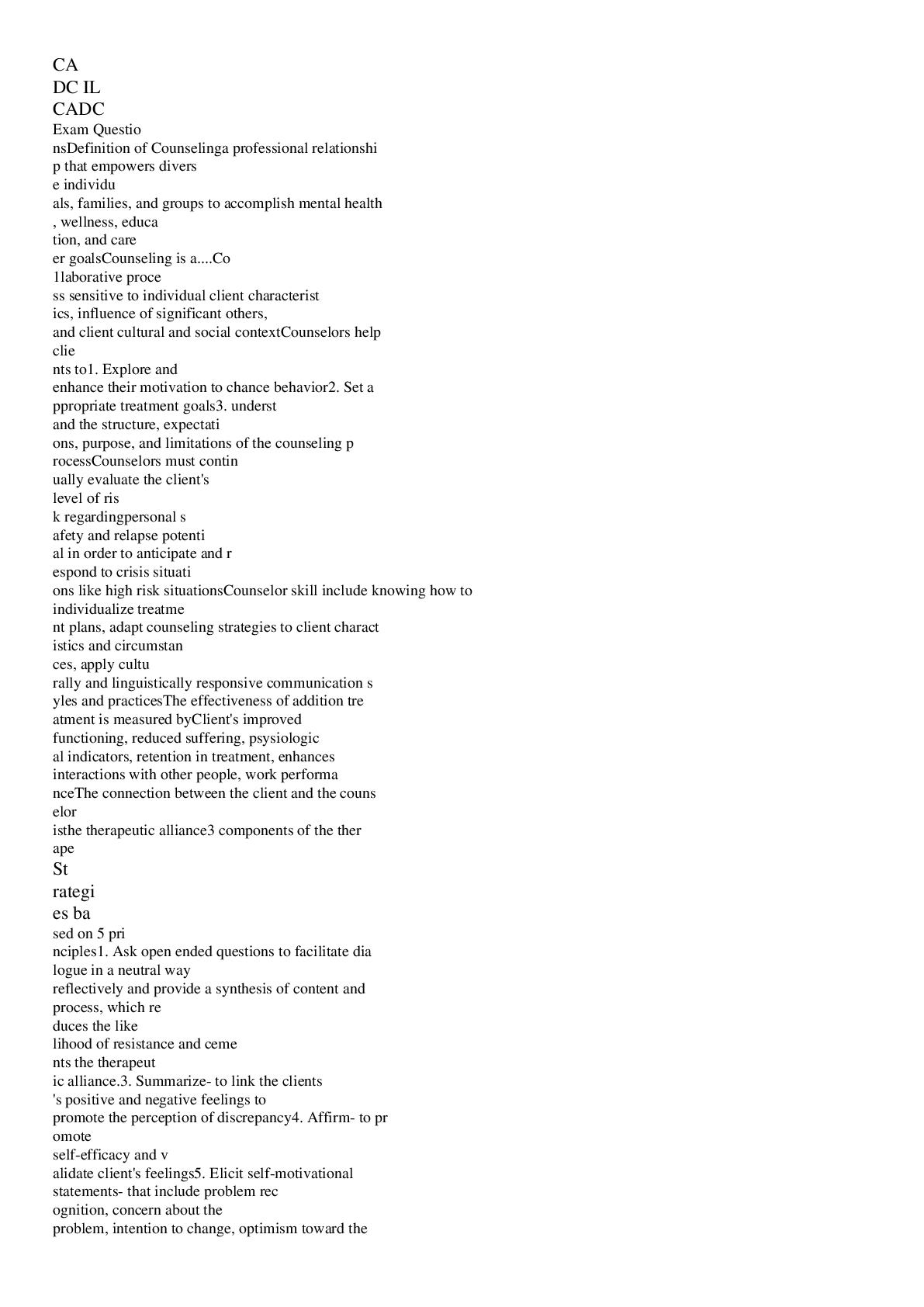
Buy this document to get the full access instantly
Instant Download Access after purchase
Buy NowInstant download
We Accept:

Reviews( 0 )
$10.00
Can't find what you want? Try our AI powered Search
Document information
Connected school, study & course
About the document
Uploaded On
Oct 16, 2022
Number of pages
7
Written in
All
Additional information
This document has been written for:
Uploaded
Oct 16, 2022
Downloads
0
Views
147

